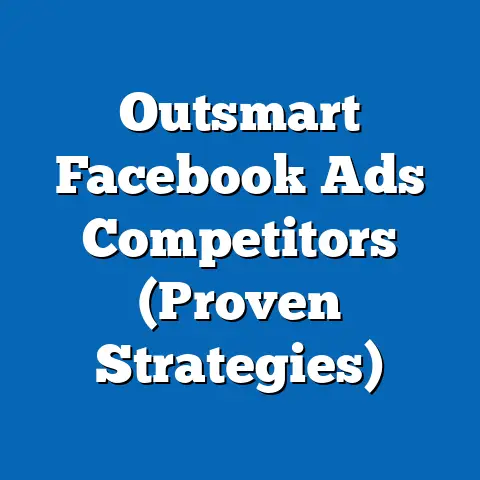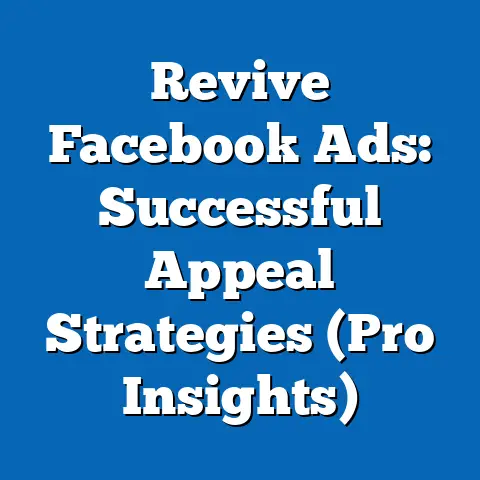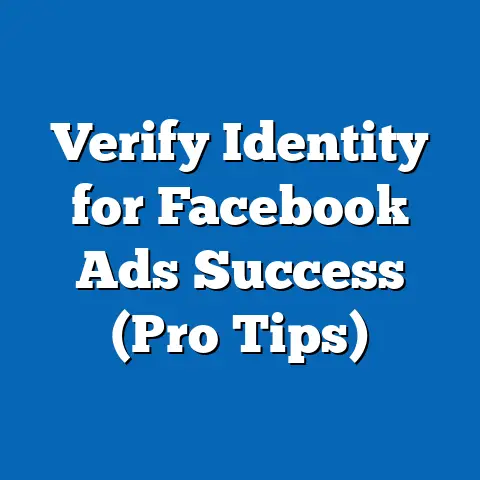Seamless Facebook Ads Transfer (Expert Step-by-Step Guide)
In the rapidly evolving landscape of digital marketing, the ability to transfer Facebook Ads seamlessly between accounts, ad managers, or even business entities represents a significant value-for-money proposition for advertisers and businesses. This process, often underutilized or misunderstood, allows marketers to maintain campaign continuity, preserve valuable data, and optimize advertising efforts without the loss of critical performance metrics or audience insights. For small businesses, agencies, and large enterprises alike, mastering seamless ad transfers can result in substantial cost savings, improved efficiency, and enhanced campaign scalability.
The defining characteristics of a seamless Facebook Ads transfer include the preservation of historical data (such as engagement metrics and optimization history), minimal disruption to ongoing campaigns, and adherence to platform policies to avoid account penalties. This capability is particularly crucial in scenarios such as agency-client transitions, business mergers, or rebranding efforts. Understanding and implementing this process effectively can be a game-changer in a competitive digital advertising environment where every dollar and data point counts.
Historically, the need for ad transfers emerged as businesses and agencies increasingly relied on Facebook’s advertising platform, launched in 2007, to reach targeted audiences. As the platform evolved, so did the complexities of managing ad accounts, especially during ownership changes or structural reorganizations. This article explores the historical context of Facebook Ads management, the societal and business implications of seamless transfers, and provides a comprehensive step-by-step guide to executing these transfers with precision. Additionally, it examines the broader impact on digital marketing strategies and the evolving role of data ownership in an era of heightened privacy concerns.
Historical Context: The Evolution of Facebook Ads and Account Management
Facebook’s foray into advertising began with the introduction of “Flyers” in 2007, a rudimentary ad system targeting college students. By 2012, the platform had transformed into a sophisticated advertising ecosystem with the launch of the Ads Manager and Power Editor, tools designed to give businesses granular control over their campaigns. During this period, the concept of ad account ownership and management became more complex as businesses scaled their digital presence and agencies took on larger roles in managing ad spend for multiple clients.
The need for ad transfers became apparent as businesses encountered scenarios such as mergers and acquisitions, client handovers, or internal restructuring. Early on, transferring ads often meant losing critical data, as Facebook did not provide a native solution for preserving campaign history across accounts. Marketers resorted to manual workarounds, such as duplicating campaigns or exporting/importing data, which were time-consuming and prone to errors.
In response to user feedback, Facebook (now Meta) introduced features within Business Manager around 2014 to facilitate smoother transitions. The ability to assign roles, transfer ownership, and manage permissions helped address some challenges, but seamless ad transfers remained a nuanced process requiring technical expertise. Significant updates, such as the introduction of asset transfer tools and stricter data privacy policies following the 2018 Cambridge Analytica scandal, further shaped how ad transfers are conducted today. These historical developments underscore the growing importance of data integrity and compliance in digital advertising.
Societal and Business Implications of Seamless Ad Transfers
The ability to transfer Facebook Ads seamlessly has far-reaching implications for businesses, agencies, and the broader digital economy. At a societal level, it reflects the increasing reliance on data-driven marketing and the need for transparency in how data is handled during transitions. With growing scrutiny over data privacy—evidenced by regulations like the General Data Protection Regulation (GDPR) in Europe and the California Consumer Privacy Act (CCPA)—seamless transfers must balance efficiency with compliance to protect user information embedded in ad campaigns.
For businesses, seamless ad transfers translate to operational agility. Small and medium-sized enterprises (SMEs), for instance, can pivot quickly during rebranding or partnerships without losing the momentum of their advertising efforts. Agencies managing multiple clients benefit by maintaining campaign performance during client onboarding or offboarding, thus preserving trust and credibility.
Economically, the cost savings associated with avoiding campaign restarts or data loss are significant. According to a 2022 study by eMarketer, businesses spend an average of $1,500 to $5,000 per month on Facebook Ads, depending on their industry and scale. Losing historical data during a transfer can result in weeks of re-optimization, costing thousands in wasted ad spend. Seamless transfers, therefore, directly impact the bottom line by minimizing disruptions.
Culturally, the practice highlights a shift toward data as a currency in the digital age. The ownership and transfer of ad data raise ethical questions about who ultimately “owns” audience insights—businesses, agencies, or the platforms themselves. As Meta continues to refine its policies, the societal conversation around data stewardship and digital rights will likely intensify.
Key Defining Characteristics of Seamless Facebook Ads Transfer
A seamless Facebook Ads transfer is characterized by several core elements that ensure minimal disruption and maximum value retention. First, it involves the preservation of historical performance data, such as click-through rates, conversion metrics, and audience engagement history, which are critical for campaign optimization. Without this data, algorithms must “relearn” audience behaviors, often leading to decreased performance in the short term.
Second, a seamless transfer adheres to Meta’s policies and guidelines, ensuring that the process does not violate terms of service or result in account suspensions. This includes obtaining proper permissions and maintaining transparency with all stakeholders involved in the transfer.
Third, it minimizes downtime or disruption to active campaigns. A truly seamless process allows ads to continue running (or be paused and resumed) without significant lapses in delivery or targeting accuracy. These characteristics collectively define a transfer process that prioritizes efficiency, compliance, and performance continuity.
Step-by-Step Guide to Seamless Facebook Ads Transfer
Below is a detailed, expert-level guide to executing a seamless Facebook Ads transfer. This guide assumes basic familiarity with Facebook Ads Manager and Business Manager. Always ensure you have the necessary permissions and access levels before initiating any transfer.
Step 1: Assess Ownership and Permissions
Before initiating a transfer, confirm that you have administrative access to both the source and destination ad accounts within Facebook Business Manager. Navigate to Business Settings > Accounts > Ad Accounts to verify ownership or request access if needed. If transferring between different Business Managers, ensure that the receiving party accepts the transfer request promptly to avoid delays.
Additionally, document all active campaigns, ad sets, and creatives in the source account. This step acts as a safeguard in case data is inadvertently lost during the process. Use tools like Ads Manager’s export feature to download campaign data for reference.
Step 2: Understand Transferable Assets
Not all elements of a Facebook Ad campaign can be transferred seamlessly. Campaign structures, ad creatives, and certain settings can typically be moved, but historical performance data and pixel data may not always transfer intact, depending on the method used. Review Meta’s official documentation on asset transfers to understand limitations, especially regarding custom audiences and lookalike audiences tied to specific pixels.
For assets that cannot be directly transferred, such as pixel data, plan to set up new tracking mechanisms in the destination account. Ensure that the destination account has a properly configured Facebook Pixel or Events Manager setup to avoid data gaps post-transfer.
Step 3: Use Business Manager for Ownership Transfer
The most seamless way to transfer an entire ad account is through Business Manager. Navigate to Business Settings > Accounts > Ad Accounts, select the ad account to transfer, and click “Assign.” Choose the destination Business Manager or ad account and assign the appropriate role (e.g., Admin or Advertiser) to the receiving party.
If transferring specific campaigns or assets rather than an entire account, use the “Export & Import” feature in Ads Manager. Export the desired campaigns as a CSV file, then import them into the destination account. Note that this method may not preserve historical data, and campaigns may need to be re-optimized.
Step 4: Transfer Associated Assets
Beyond campaigns, consider associated assets like custom audiences, lookalike audiences, and creative assets (images, videos, etc.). Custom audiences can often be shared between accounts within the same Business Manager by adjusting permissions in the Audiences section. For lookalike audiences, you may need to recreate them in the destination account if they are tied to a non-transferable pixel.
For creative assets, use the Creative Hub or manually download/upload assets to the new account. Ensure that all links, tracking parameters, and call-to-action buttons are updated to reflect the new account’s objectives or landing pages.
Step 5: Notify Stakeholders and Update Billing
Inform all relevant stakeholders—such as clients, team members, or partners—about the transfer timeline and any expected downtime. Transparency helps manage expectations and prevents miscommunication. If the transfer involves a change in billing ownership, update payment methods in Business Settings to avoid disruptions due to declined transactions.
Double-check that the destination account has sufficient budget allocated and that spending limits are adjusted accordingly. This step is critical for uninterrupted campaign delivery.
Step 6: Test and Monitor Post-Transfer
Once the transfer is complete, closely monitor the performance of transferred campaigns in the destination account. Check for discrepancies in delivery, targeting, or budget allocation. Run small test campaigns if necessary to ensure that tracking pixels and audience targeting are functioning as expected.
Use Meta’s Ads Reporting tools to compare pre- and post-transfer performance metrics. Address any issues promptly, such as broken links or missing creatives, to minimize impact on campaign effectiveness.
Step 7: Document and Optimize
Finally, document the transfer process, including any challenges encountered and solutions implemented. This record serves as a reference for future transfers and helps refine internal workflows. Optimize transferred campaigns based on initial performance data, adjusting bids, audiences, or creatives as needed to align with the destination account’s goals.
Technological Factors Influencing Seamless Transfers
The feasibility and success of seamless Facebook Ads transfers are heavily influenced by technological advancements within Meta’s ecosystem. The introduction of Business Manager in 2014 was a pivotal development, providing a centralized platform for managing multiple ad accounts and permissions. Subsequent updates, such as automated asset transfer tools and API integrations, have further streamlined the process for developers and large-scale advertisers.
However, technological limitations persist. For instance, the inability to transfer certain types of historical data or pixel-based audiences highlights gaps in Meta’s infrastructure. Additionally, platform updates—such as the iOS 14 privacy changes in 2021 that impacted tracking capabilities—can introduce new challenges to maintaining data continuity during transfers. Staying abreast of these changes is essential for advertisers aiming to execute seamless transfers.
Economic and Business Considerations
From an economic perspective, seamless ad transfers contribute to cost efficiency by reducing the need to rebuild campaigns from scratch. For agencies managing high-budget accounts, the ability to transfer campaigns without performance dips can preserve client relationships and revenue streams. A 2021 report by Forrester estimated that agencies lose up to 15% of ad spend efficiency during poorly executed account transitions, underscoring the financial stakes involved.
For businesses, particularly SMEs with limited marketing budgets, seamless transfers enable agility in responding to market changes or strategic pivots. The economic advantage lies in maintaining return on ad spend (ROAS) during transitions, a critical metric in an era where digital advertising costs continue to rise—Facebook’s average cost-per-click increased by 17% year-over-year in 2022, according to WordStream data.
Social and Cultural Dimensions
Socially, the practice of ad transfers intersects with broader discussions about data privacy and digital ethics. As campaigns often contain sensitive audience data, transferring this information raises questions about consent and ownership. Businesses and agencies must navigate these concerns transparently, ensuring compliance with regulations like GDPR, which mandates explicit user consent for data handling.
Culturally, the increasing reliance on digital advertising reflects a societal shift toward online consumption and personalized marketing. Seamless transfers enable brands to maintain consistent messaging across ownership changes, reinforcing brand identity in a fragmented digital landscape. However, this also amplifies the risk of over-targeting or data misuse, fueling public skepticism about digital platforms—a sentiment evident in surveys like the 2023 Pew Research Center study, which found that 64% of Americans worry about how companies use their data.
Comparative Analysis: Seamless Transfers Across Platforms
While this article focuses on Facebook Ads, it’s worth comparing Meta’s transfer capabilities with those of other platforms like Google Ads or LinkedIn Ads. Google Ads, for instance, offers a relatively straightforward process for transferring campaigns between accounts via the Google Ads Editor, with robust preservation of historical data. However, Google’s process requires manual intervention for certain assets, similar to Meta’s limitations with pixel data.
LinkedIn Ads, on the other hand, has more restrictive transfer policies, often necessitating full campaign rebuilds during account changes. This comparison highlights Meta’s middle-ground approach—offering tools for seamless transfers while still imposing technical constraints. Advertisers managing multi-platform campaigns must account for these differences when planning transitions, as platform-specific policies can significantly impact overall strategy.
Nuances and Diversity in Transfer Scenarios
Not all ad transfer scenarios are identical, and the approach must be tailored to specific contexts. For instance, transferring ads for a small business with a single ad account differs vastly from managing a transfer for a multinational corporation with dozens of regional accounts. Similarly, agency-client transfers often involve additional layers of complexity, such as contractual agreements or client approval processes.
The diversity of user needs also extends to technical proficiency. While experienced marketers may navigate transfers with ease, less tech-savvy users may struggle with Meta’s interface or terminology. This underscores the importance of accessible documentation and support resources, as well as the potential for third-party tools or consultants to bridge knowledge gaps.
Implications for Digital Marketing and Beyond
The ability to execute seamless Facebook Ads transfers has profound implications for digital marketing strategies. It empowers businesses to adapt quickly to changing circumstances—whether due to mergers, rebranding, or agency transitions—without sacrificing campaign performance. This agility is particularly critical in fast-paced industries like e-commerce, where timing and audience engagement are paramount.
In the workplace, seamless transfers influence how marketing teams and agencies collaborate. Clear protocols for transfers can reduce friction during client handovers, fostering trust and accountability. Conversely, poorly managed transfers can strain professional relationships and damage reputations, highlighting the need for standardized best practices.
Looking beyond marketing, seamless ad transfers touch on broader societal trends around data ownership and digital infrastructure. As platforms like Meta wield increasing influence over how data is stored and transferred, questions arise about user agency and platform accountability. These issues will likely shape future policy debates and platform updates, impacting how transfers are conducted in the years ahead.
Forward-Looking Insights and Uncertainties
As digital advertising continues to evolve, the future of seamless Facebook Ads transfers will likely be shaped by several factors. Advances in automation and AI could streamline the process further, potentially allowing for real-time data migration with minimal human intervention. Meta’s ongoing investments in machine learning, as outlined in their 2023 annual report, suggest a push toward smarter ad management tools that could enhance transfer capabilities.
However, uncertainties remain. Regulatory pressures around data privacy may impose stricter requirements for transfers, potentially limiting what data can be moved or requiring additional user consent. Platform policies are also subject to change, as seen with past updates like the removal of certain targeting options post-iOS 14. Advertisers must remain adaptable, prioritizing compliance and transparency to navigate these evolving landscapes.
Additionally, the rise of competing platforms and alternative advertising channels—such as TikTok Ads or decentralized ad networks—could influence Meta’s approach to transfers. If competitors offer more seamless solutions, Meta may be compelled to innovate further, benefiting users in the long term. Yet, the pace and direction of such innovation remain speculative, underscoring the need for ongoing vigilance and learning.
Conclusion
Seamless Facebook Ads transfer represents a critical skill in the arsenal of modern digital marketers, offering significant value for money through cost savings, data preservation, and operational efficiency. Rooted in the historical evolution of Facebook’s advertising platform, this process reflects broader societal shifts toward data-driven marketing and the ethical complexities of data ownership. By mastering the step-by-step guide provided—spanning permissions, asset transfers, and post-transfer optimization—businesses and agencies can navigate transitions with confidence and minimal disruption.
The implications of seamless transfers extend beyond individual campaigns, influencing economic outcomes, workplace dynamics, and cultural perceptions of digital advertising. While technological advancements and platform updates promise to refine the process, uncertainties around regulation and competitive pressures highlight the need for adaptability. As the digital landscape continues to evolve, the ability to execute seamless ad transfers will remain a cornerstone of effective marketing strategy, balancing innovation with responsibility in an increasingly data-centric world.






